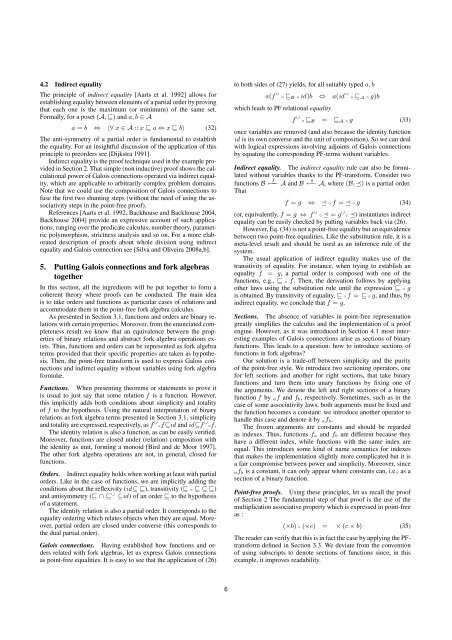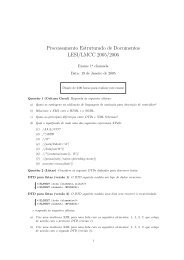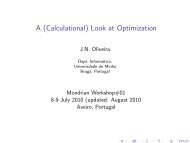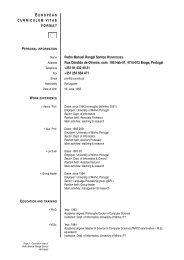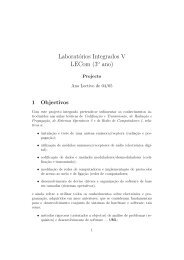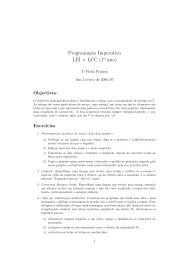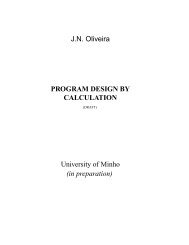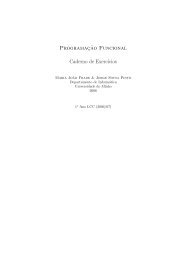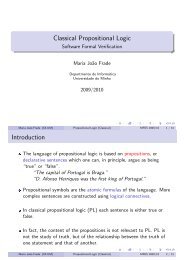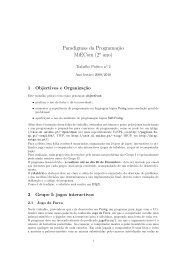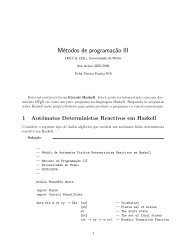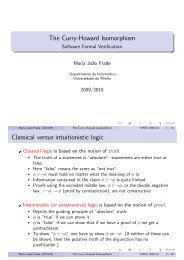Galois
Galois
Galois
Create successful ePaper yourself
Turn your PDF publications into a flip-book with our unique Google optimized e-Paper software.
4.2 Indirect equality<br />
The principle of indirect equality [Aarts et al. 1992] allows for<br />
establishing equality between elements of a partial order by proving<br />
that each one is the maximum (or minimum) of the same set.<br />
Formally, for a poset (A, ⊑) and a, b ∈ A<br />
a = b ⇔ 〈∀ x ∈ A :: x ⊑ a ⇔ x ⊑ b〉 (32)<br />
The anti-symmetry of a partial order is fundamental to establish<br />
the equality. For an insightful discussion of the application of this<br />
principle to preorders see [Dijkstra 1991].<br />
Indirect equality is the proof technique used in the example provided<br />
in Section 2. That simple (non inductive) proof shows the calculational<br />
power of <strong>Galois</strong> connections operated via indirect equality,<br />
which are applicable to arbitrarily complex problem domains.<br />
Note that we could use the composition of <strong>Galois</strong> connections to<br />
fuse the first two shunting steps (without the need of using the associativity<br />
steps in the point-free proof).<br />
References [Aarts et al. 1992, Backhouse and Backhouse 2004,<br />
Backhouse 2004] provide an expressive account of such applications,<br />
ranging over the predicate calculus, number theory, parametric<br />
polymorphism, strictness analysis and so on. For a more elaborated<br />
description of proofs about whole division using indirect<br />
equality and <strong>Galois</strong> connection see [Silva and Oliveira 2008a,b].<br />
5. Putting <strong>Galois</strong> connections and fork algebras<br />
together<br />
In this section, all the ingredients will be put together to form a<br />
coherent theory where proofs can be conducted. The main idea<br />
is to take orders and functions as particular cases of relations and<br />
accommodate them in the point-free fork algebra calculus.<br />
As presented in Section 3.1, functions and orders are binary relations<br />
with certain properties. Moreover, from the enunciated completeness<br />
result we know that an equivalence between the properties<br />
of binary relations and abstract fork algebra operations exists.<br />
Thus, functions and orders can be represented as fork algebra<br />
terms provided that their specific properties are taken as hypothesis.<br />
Then, the point-free transform is used to express <strong>Galois</strong> connections<br />
and indirect equality without variables using fork algebra<br />
formulæ.<br />
Functions. When presenting theorems or statements to prove it<br />
is usual to just say that some relation f is a function. However,<br />
this implicitly adds both conditions about simplicity and totality<br />
of f to the hypothesis. Using the natural interpretation of binary<br />
relations as fork algebra terms presented in Section 3.1, simplicity<br />
and totality are expressed, respectively, as f ∪ ◦f⊆id and id⊆f ∪ ◦f.<br />
The identity relation is also a function, as can be easily verified.<br />
Moreover, functions are closed under (relation) composition with<br />
the identity as unit, forming a monoid [Bird and de Moor 1997].<br />
The other fork algebra operations are not, in general, closed for<br />
functions.<br />
Orders. Indirect equality holds when working at least with partial<br />
orders. Like in the case of functions, we are implicitly adding the<br />
conditions about the reflexivity (id⊆ ⊑), transitivity (⊑ ◦ ⊑ ⊆ ⊑)<br />
and antisymmetry (⊑ ∩ ⊑ ∪ ⊆id) of an order ⊑ to the hypothesis<br />
of a statement.<br />
The identity relation is also a partial order. It corresponds to the<br />
equality ordering which relates objects when they are equal. Moreover,<br />
partial orders are closed under converse (this corresponds to<br />
the dual partial order).<br />
<strong>Galois</strong> connections. Having established how functions and orders<br />
related with fork algebras, let us express <strong>Galois</strong> connections<br />
as point-free equalities. It is easy to see that the application of (26)<br />
to both sides of (27) yields, for all suitably typed a, b<br />
a(f ∪ ◦ ⊑ B ◦ id)b ⇔ a(id ∪ ◦ ⊑ A ◦ g)b<br />
which leads to PF relational equality<br />
f ∪ ◦ ⊑ B = ⊑ A ◦ g (33)<br />
once variables are removed (and also because the identity function<br />
id is its own converse and the unit of composition). So we can deal<br />
with logical expressions involving adjoints of <strong>Galois</strong> connections<br />
by equating the corresponding PF-terms without variables.<br />
Indirect equality. The indirect equality rule can also be formulated<br />
without variables thanks to the PF-transform. Consider two<br />
functions B ←− f<br />
A and B ←− g<br />
A, where (B, ≼) is a partial order.<br />
That<br />
f = g ⇔ ≼ ◦ f = ≼ ◦ g (34)<br />
(or, equivalently, f = g ⇔ f ∪ ◦ ≼ = g ∪ ◦ ≼) instantiates indirect<br />
equality can be easily checked by putting variables back via (26).<br />
However, Eq. (34) is not a point-free equality but an equivalence<br />
between two point-free equalities. Like the substitution rule, it is a<br />
meta-level result and should be used as an inference rule of the<br />
system.<br />
The usual application of indirect equality makes use of the<br />
transitivity of equality. For instance, when trying to establish an<br />
equality f = g, a partial order is composed with one of the<br />
functions, e.g., ⊑ ◦ f. Then, the derivation follows by applying<br />
other laws using the substitution rule until the expression ⊑ ◦ g<br />
is obtained. By transitivity of equality, ⊑ ◦ f = ⊑ ◦ g, and thus, by<br />
indirect equality, we conclude that f = g.<br />
Sections. The absence of variables in point-free representation<br />
greatly simplifies the calculus and the implementation of a proof<br />
engine. However, as it was introduced in Section 4.1 most interesting<br />
examples of <strong>Galois</strong> connections arise as sections of binary<br />
functions. This leads to a question: how to introduce sections of<br />
functions in fork algebras<br />
Our solution is a trade-off between simplicity and the purity<br />
of the point-free style. We introduce two sectioning operators, one<br />
for left sections and another for right sections, that take binary<br />
functions and turn them into unary functions by fixing one of<br />
the arguments. We denote the left and right sections of a binary<br />
function f by af and f b , respectively. Sometimes, such as in the<br />
case of some associativity laws, both arguments must be fixed and<br />
the function becomes a constant: we introduce another operator to<br />
handle this case and denote it by af b .<br />
The frozen arguments are constants and should be regarded<br />
as indexes. Thus, functions f a and f b are different because they<br />
have a different index, while functions with the same index are<br />
equal. This introduces some kind of name semantics for indexes<br />
that makes the implementation slightly more complicated but it is<br />
a fair compromise between power and simplicity. Moreover, since<br />
af b is a constant, it can only appear where constants can, i.e., as a<br />
section of a binary function.<br />
Point-free proofs. Using these principles, let us recall the proof<br />
of Section 2 The fundamental step of that proof is the use of the<br />
multiplication associative property which is expressed in point-free<br />
as :<br />
(×b) ◦ (×c) = × (c × b) (35)<br />
The reader can verify that this is in fact the case by applying the PFtransform<br />
defined in Section 3.3. We deviate from the convention<br />
of using subscripts to denote sections of functions since, in this<br />
example, it improves readability.<br />
6


